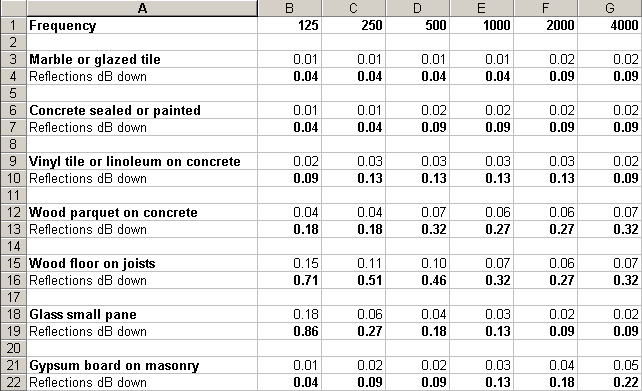|
|
"The thin wood in a violin is meant to vibrate and add pleasing resonances. Good listening rooms must aim to avoid all resonances." |
By
Ethan Winer The conventional wisdom is that wood surfaces impart a "warm" sound to a room, compared to cement, linoleum, or drywall. But is this really true? In the context of wall and floor surfaces, what matters most is the surface's reflectivity. That is, how much of the sound that strikes the surface is reflected at various frequencies. I visit a lot of audio forums every day, and posts like this are common:
I've seen people argue that wood adds a pleasing quality to a room in the same way wood affects the tone of a fine violin. But that's a false analogy because the thin, resonant wood in a violin is meant to vibrate and add pleasing resonances. Versus wood on a floor or wall that is much thicker, and is often anchored solidly to the wall or floor backing. Indeed, resonances in a musical instrument are desirable and even necessary, but good recording and listening rooms must aim to avoid all resonances as much as possible. I've also seen people claim that the sound of wood versus cement is so obviously different that you need only listen to hear it. But this too is a false analogy unless you can audition (and hopefully measure) two identical rooms where the only difference is the surface materials. Many professional recording studios these days have stained cement floors instead of wood for various reasons including cost. Linoleum is common too, and should reflect sound about the same as cement or wood. But to learn for certain, I created the table below showing the strength of reflections in standard octave frequency bands for several common floor and wall surface materials. Top |
|
 |
| This screen image from the Excel file linked
below shows the surface reflectivity of some common building materials. The upper row
across for each material shows its absorption coefficient. The lower numbers in bold are
computed from that showing how much of the sound is reflected in each frequency range. Absorption data source: SAE College |
|
"You can see that all of the surfaces reflect the same to within less than half a dB." |
The surface reflectivity
shown above is the reciprocal of its absorption. If a material absorbs 1 percent of the
sound, that means 99 percent is reflected*. From this it's easy to convert the percent
reflectivity to decibels. Here's the entire formula:
* Note that this assumes the surface is on a solid backing, not suspended in air. When a material is suspended in air, some of the sound - mostly lower frequencies - will go through it rather than be reflected. This brings up an important point. When a glass mirror is attached to a rigid sheet rock wall, the glass simply reflects high frequencies a little more than the wall. Likewise, drywall glued to solid cement or brick will reflect high frequencies a little less due to the slightly absorbing paper facing. But glass and drywall are often mounted in a way that allows flexing. When a large sheet of window glass is free to flex in a frame, or drywall is attached to wood or metal studs, sympathetic vibration can increase their absorption at lower frequencies. This is evident in the table for a pane of glass and a wood floor resting on joists. CONCLUSION You can see that all of these surfaces reflect the same to within less than 1 dB, and in most cases well under half a dB. In my opinion, surfaces that reflect the same to within a dB or less will sound pretty much identical. Some people believe that wood and cement and linoleum all sound different, but in my opinion any difference heard is most likely due to other factors such as the size and shape of the rooms, and other surfaces present. One failing of the data used to calculate reflectivity is it goes no higher than 4 KHz*. I suspect that any differences between materials will be greater at the highest frequencies. For example, glass and ceramic tile probably reflect more at 8 KHz and above compared to woods having a rough unfinished surface. But even at those high frequencies, sealed concrete is likely very similar to polished or plastic coated wood parquet flooring. * Added January 31, 2010: The section below shows the decay times I measured from 2 KHz to 20 KHz inside a small box made of MDF with and without a glass lining. If you download my Excel Spreadsheet you can add other materials whose absorption is known, and calculate their surface reflectivity using the extra cells included for that. Top |
The test results that follow were part of an experiment to determine how long a decay time could be achieved in a small box. The photo below shows the setup, with a tweeter at one end and a DPA 4090 measuring microphone at the other. I measured the decay times in the MDF box when empty, then again after lining the top and bottom and sides with glass. Adding the glass lining increased the decay time at high frequencies, though less than I expected. The box measures 37.75 by 22.5 by 14.5 inches inside.
|
|||||
|
|||||
Entire contents
of this site Copyright © 2004- by RealTraps, LLC. All rights reserved. |